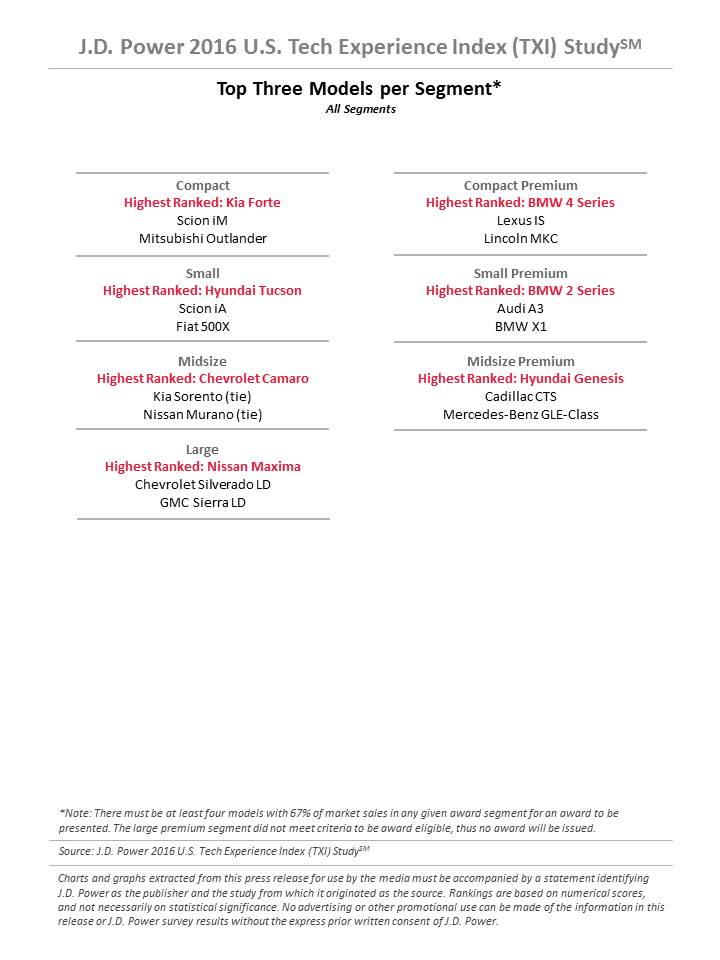2016 U.S. Tech Experience Index Study: Safety Technologies Have Highest Satisfaction; Navigation Lags
The inaugural J.D. Power 2016 U.S. Tech Experience Index (TXI) StudySM recognizes BMW and Hyundai as the highest-ranked car brands in overall customer experience with vehicle technology in their respective segments.
The new TXI Study measures a vehicle owner’s experiences, usage, and interaction with driver-centric vehicle technology after 90 days of ownership. The major technology categories analyzed in the study include collision protection; comfort and convenience; driving assistance; entertainment and connectivity; navigation; and smartphone mirroring.
BMW and Hyundai both hold two “firsts” in the study. BMW’s 2 Series tops the list in the Small Premium segment, while its 4 Series earns top honors in the Compact Premium segment. The Hyundai Genesis is the leader in the Midsize Premium segment, and the Tucson ranks first in the Small segment.
Other models that rank highest in their segment are the Chevrolet Camaro (Midsize); Kia Forte (Compact); and Nissan Maxima (Large). Model-level rankings and awards include 2016 model-year vehicles that were all-new or redesigned within the past three years.

Safety Technologies Reign
The collision protection category holds the highest overall satisfaction among the five groups of technologies included in the study index scores,1 with a score of 754 on a 1,000-point scale. Navigation system scores lowest of the five: 687.
“For any technology in a vehicle, it’s critical that the owners want it, are aware they have it, and know how to use it,” said Kristin Kolodge, executive director of driver interaction & HMI research at J.D. Power. “It is alarming how many technologies consumers have in their vehicle but aren’t using because they don’t know they have them or don’t know how to use them. Both of these knowledge gaps have long-term implications for future demand.
The Role of the Dealer
Even if owners are aware they have an in-vehicle technology doesn’t mean they will use it.
“The dealer plays a critical role in whether or not a technology is used. When the dealer takes the time to explain the technology or provide a demonstration, it not only makes the owner aware they have the technology, but also helps them understand how to use it, which means they are more likely to use it, continue to use it and, because they see the value, want it in their next vehicle. By taking the time to show the technology to the new owner, the dealer can mitigate DTU issues, improving both satisfaction and quality. The navigation system is just one area. If the dealer explains all or many of the technologies to the new owner, it can have a dramatic positive effect on the ownership experience.”
The insurance industry is closely tracking the use of vehicle safety-related technologies that might help prevent or mitigate collisions and protect occupants when there is an accident. One insurer, Liberty Mutual Insurance, offers a vehicle safety discount for teens driving a vehicle equipped with safety features such as lane-departure warning, adaptive cruise control, and collision preparation systems.2
“As auto insurers begin to offer discounts for vehicle safety features, this may help raise consumer awareness that they actually have these technologies and the knowledge to use them properly,” said Jessica McGregor, director of the insurance practice at J.D. Power.
Overall satisfaction varies greatly by segment. Satisfaction is highest in the Large segment (755), followed by the Small Premium segment (735); Compact Premium segment (732); Midsize Premium segment (731); Compact segment (727); Midsize segment (725); and the Small segment (706).
“It’s not just how much technology you have in the vehicle, but how well it’s delivered,” Kolodge concluded. “The technology’s usability and how well it is integrated into the vehicle are critical—that has to be done right.”
Consumer Tips
Based on the study, J.D. Power offers the following consumer tips:
Familiarize yourself with new technologies during the vehicle shopping process, not after you’ve made the purchase.
Find out whether having certain safety features in your vehicle will lower your insurance premiums.
Compare the way technology is delivered, model to model. If you will depend on a certain technology, consider paying a little more for the vehicle that offers the best of that technology.
About the Study
The 2016 U.S. Tech Experience Index (TXI) Study is based on a survey of 17,864 vehicle owners and lessees. Awards are based solely on responses from the 13,269 consumers who purchased or leased a new 2016 model-year vehicle in the previous 90 days that has been considered an all-new or redesigned vehicle within the past 3 years. The study was fielded from February through August 2016.
1Smartphone mirroring is not included in the official index calculation
2Source: Liberty Mutual Insurance, https://www.libertymutual.com/
Additional Research:
Abstract:
The inaugural J.D. Power 2016 U.S. Tech Experience Index (TXI) Study recognizes BMW and Hyundai as the highest-ranked car brands in overall customer experience with vehicle technology in their respective segments.
Year:
2 016
Check this if this is NOT an Articles Listing Page:
New or Used:
New
Display Article Date?:
Article Is Flipbook:
No

 Yahoo Autos
Yahoo Autos 
